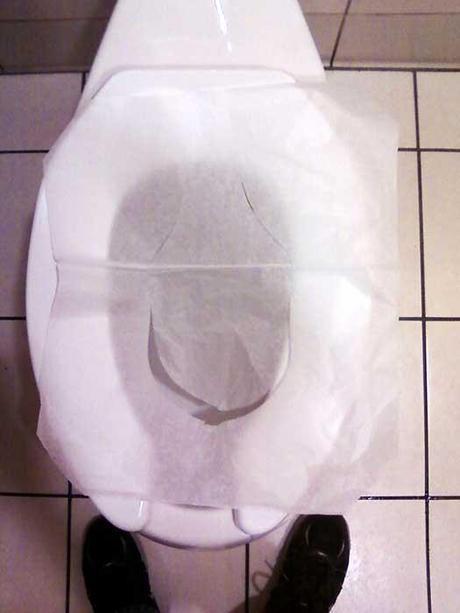Research finds that toilet seat liners offer no hygienic benefits. This begs the age old question, “do you hover, or do you cover.”
Even though we do everything we can to avoid it, there’s no doubt that you’ve had to use a public restroom at some point in time. No need to feel ashamed, we’ve all had to tuck our chins and take the walk of shame to the public restroom. Do you hover, or do you cover? Well new research may give insight into the best option.
- 60% of American refuse to sit when they use a public toilet. Source.
- Nearly 30% of Americans avoid public restrooms out of fear of germs and 40% flush with their feet. Source.

Should you Cover or Hover? CC)
Germs & STD’s on Toilet Seats: Fact or Fiction?
I’m going to take it straight from the horse’s mouth on this one. WebMD has this to say about germs and STD’s on toilet seats:
“The Toilet seat is NOT a common vehicle for transmitting infections to humans. Many disease-causing organisms can survive for only a short time on the surface of the seat, and for an infection to occur, the germs would have to be transferred from the toilet seat to your urethral or genital tract, or through a cut or sore on the buttocks or thighs, which is possible but very unlikely.”
” Yes, there can be plenty of bugs lying in wait in public restrooms, including both familiar and unfamiliar suspects like streptococcus, staphylococcus, E. coli and shigella bacteria, hepatitis A virus, the common cold virus, and various sexually transmitted organisms. But if your immune system is healthy, and if you adopt simple hygienic measures like handwashing, you should be able to deliver a knockout punch to most of what you encounter and perhaps put your “germ-phobia” to rest.”
You heard that right, the only disease that you can really get from toilet seats are cooties. Ooooh. But don’t listen to me, take it from PHD Abigail Salyers who is the President of the American Society for Microbiology:
“To my knowledge, no one has ever acquired an STD on the toilet seat…”
Okay, but I never trust what one person says. So I looked for even more validation. Dr. William Schaffner, Professor of Preventative Medicine at Vanderbilt University Medical Center said this:
“That’s because toilet seats are not a vehicle for the transmission of any infectious agents — you won’t catch anything.”
In general, germs must come into contact with open cuts or bodily openings in order for the disease/germ to be transmitted. Making sure that you wipe the toilet seat before sitting down will likely do more good than placing a seat cover on top of it. Seat covers are paper thin and fluids can soak through these thin sheets (yuck, I know).
Do Toilet Seat Liners Work?
Toilet seat covers DO NOT work. They are more so to assuage your ego and make you feel cleaner and safer. It probably doesn’t hurt to use them but only using a toilet seat cover is far from being hygienically sound. I like the way this Redditor phrased it:
“…toilet seat covers work, in theory, as some sort of protection against the dreaded ‘toilet seat STD’, but I can’t help but think a thin sheet of paper isn’t going to do anything…”
In order to make sure that you don’t get any harmful diseases, you must follow proper hand washing techniques. Recently it was found that automatic faucets actually carry more germs than manually operated faucets. Go with the manual faucet if you have the choice!

What ever you do, don’t fall in! (CC)
E.Coli and other bacteria CAN survive on toilet seats indefinitely but your skin is designed to be a natural barrier from micro organisms. These micro organisms are found all around the bathroom and not just on the toilet seat.
- Cutting board has 200 times more fecal matter on it than a toilet seat!
- A dish sponge has 200,000 times more bacteria than a toilet seat!
- 1 in 6 smart phones have traces of feces on them.
“If you have a choice between licking a cutting board or a toilet seat, pick the toilet seat.” – Chuck Gerba, University of Arizona Microbiologist
Cover or Hover: That is the Question
It was once thought that toilet seats were once capable of transmitting gastrointestinal and sexually transmitted infections but research has disproved this theory time and time again.
The answer is NEITHER! A simple sight test will be able to tell you if it’s safe to sit on a toilet seat. You can simply wipe the seat down with toilet paper and make sure that there are no sharp objects that could pierce or scratch your skin. If you have open wounds on your buttocks, then it would be fitting to hover while you do your business.
More Reading:
- 10 Things You Must Wash Your Hands After Touching
- Why are Americans Holding Out on the Bidet
- You’re Not Dreaming: The Touchless Toilet is Here
- Desheeting: Are Toilet Paper Companies Skimping You?
About the Author
Cheryl Khan is a designer and writer at Tradewinds Imports.com, an online specialty site dedicated to retailing fine bathroom furnishings. She has extensive knowledge about all the finer details that go into planning the perfect bath renovation project and is an expert on all things bathroom! Send her your bathroom Q’s on twitter @SuperInteriors!
